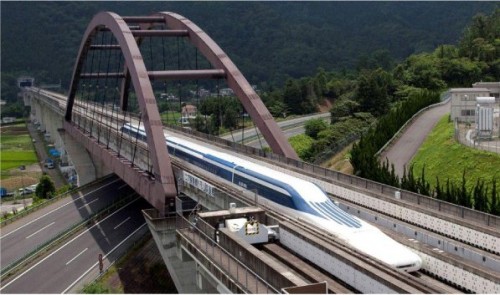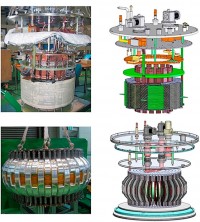
Trains levitated by superconducting magnets could be in commercial service in less than 15 years (Courtesy: Shigehiro Nishijima et al.)
By Hamish Johnston
When I think of superconductivity, applications that could improve the environment don’t usually come to mind. Perhaps that’s because superconductors only work at very low temperatures and lots of energy is needed to cool them. However, a review article just published in the IOP Publishing journal Superconductor Science and Technology points out some interesting environmental applications.
One that wet my whistle involves purifying water using the very high magnetic-field gradients that can be created using superconductors. When water contaminated with tiny particles is passed through such a gradient, the magnetic forces on the particles are so strong that the particles are shunted in one direction and removed from the flow. If the particles are not magnetic, they can be “seeded” by adding a magnetic material to the water that adheres to the target particles. Indeed, this can even be done to remove unwanted molecules.
Another environment-related application mentioned in the review is using superconducting cables to transmit electrical energy over long distances without significant loss. This could come in handy, for example, for transmitting solar energy from sunny western China to distant cities on the east coast. While some experimental transmission systems exist already, the big challenge is to minimize both the energy required to cool the superconducting cables and the cost of the superconducting cable itself. Unfortunately, cheap superconductors tend to be more expensive to cool and vice versa, so more work needs to be done.
Also energy-related is the storage of electrical energy in the magnetic field of a huge superconducting magnet. Such systems are already being used on a small scale to stabilize power supplies for very sensitive industrial equipment. Someday, however, the technology could be used to smooth out the peaks and troughs in the output of wind, solar and other renewable energy sources.
Energy-efficient magnetic-levitation transportation is another possible application, with the review describing a planned superconductor-enabled train in Japan that is expected to carry passengers a 500 km per hour by 2027. According to the review, such trains would produce less than one-third of the carbon dioxide per passenger than an aircraft for the 400 km journey between Tokyo and Osaka.
The review article is called “Superconductivity and the environment: a Roadmap“and was written by a team of researchers at 13 institutes worldwide.
You can read much more about superconductors and their commercial applications in the April 2011 issue of Physics World, which celebrated the centenary of superconductivity. Download your free PDF copy.

As pointed out clearly in the document, the superconducting materials with very strong magnetic field can be used in different domains. However, to make the material superconducting, one needs rather involved cryogenic systems containg helium cooled down to a couple of degrees Kelvin. The things should become much more tractable with High-T superconductors that need only much cheaper liquid nitrogen and the things would become even better, if one can produce room-T superconductors. A lot of research work is going on here at present.
Put superconductors in large, offshore 10MW wind turbine generators to make them smaller, lighter, more efficient, use less rare earth and suit direct drive (no gearbox to fail) and you will have economic benefit – and Cryox-STFC will take care of the (non-trivial) cryogenic components. John Vandore
Hamish, Can I take isue with two quotes from your blog : ‘lots’ of energy is needed to cool [superconductors] – cryogeic technology need not be inefficient, so isn’t ‘lots’ a rather loose term ? [I’m increasingly of the view that there is some rather out-of-date, anti-cryogenic prejudice abroad … mature, evolved cryogenic technology can be reliable, efficient and not necessarily expensive. You talk about ‘involved cryogenic systems’ containing helium. Is that really appropriate given the ubiquity of helium cooling systems in every hospital on the planet with an MRI system ? Please help us stamp out anti-cryogenic prejudice ! John V